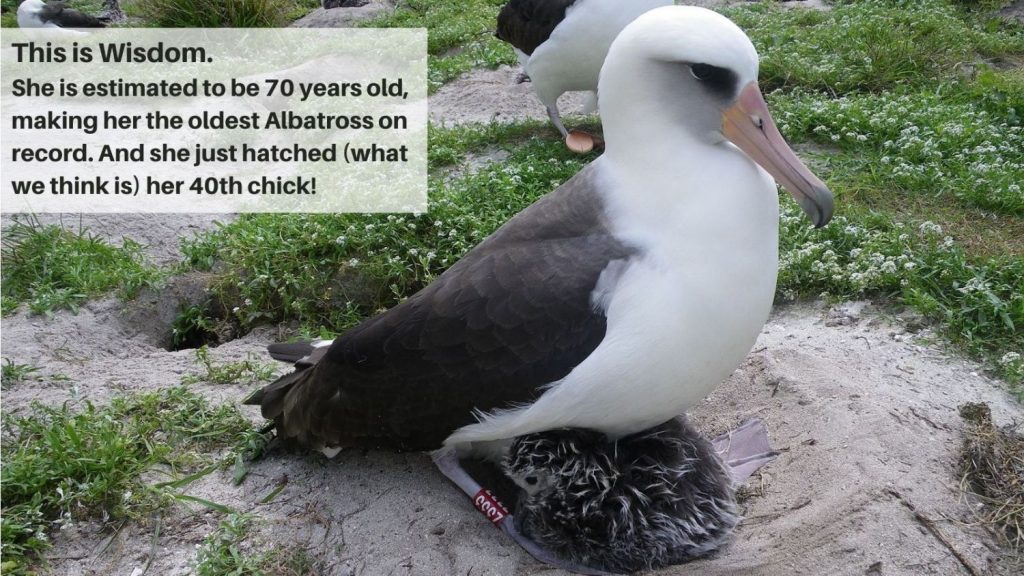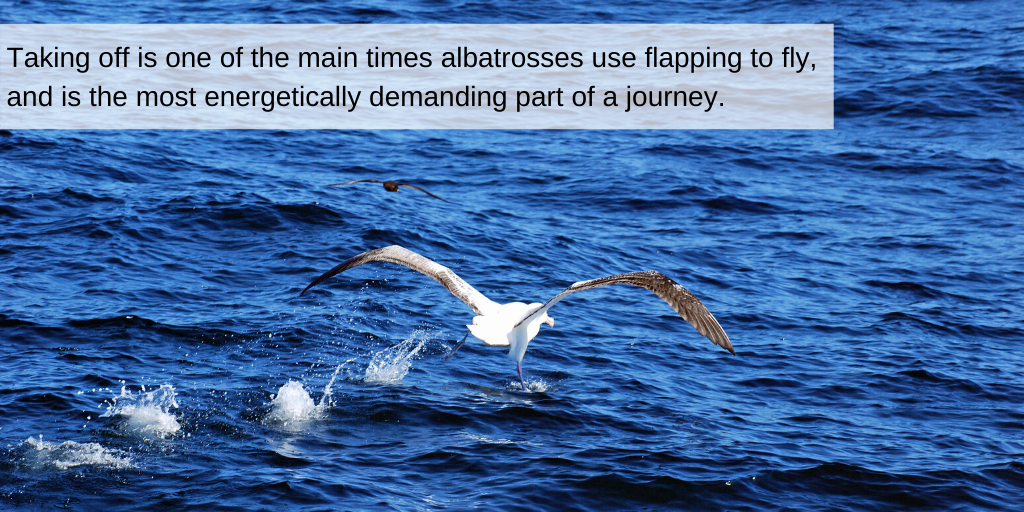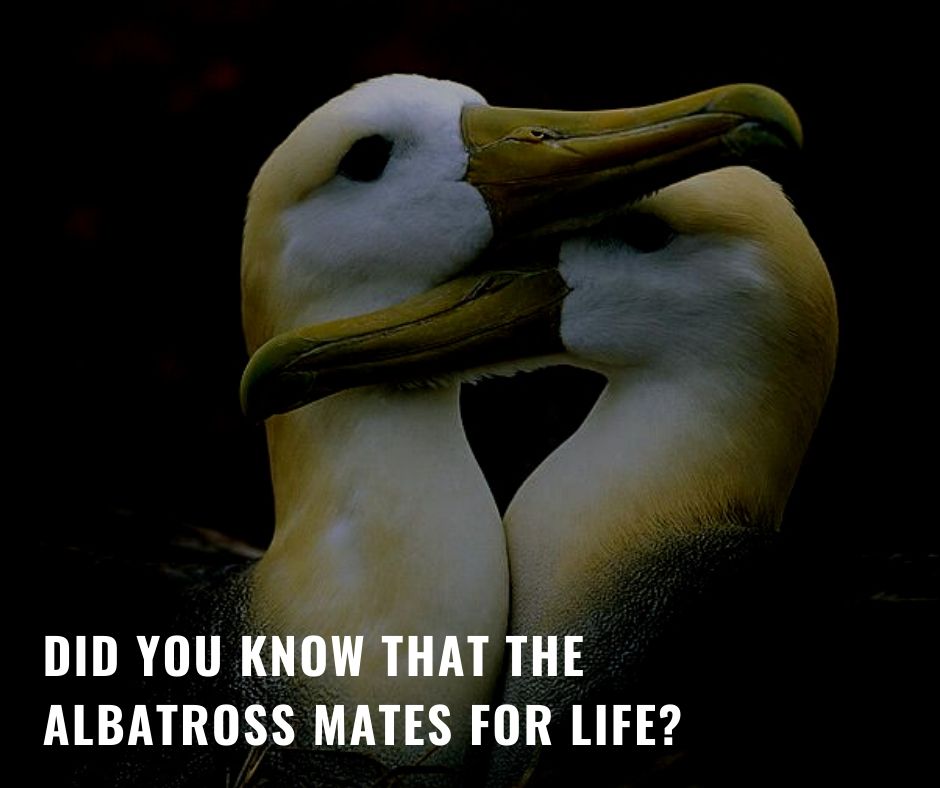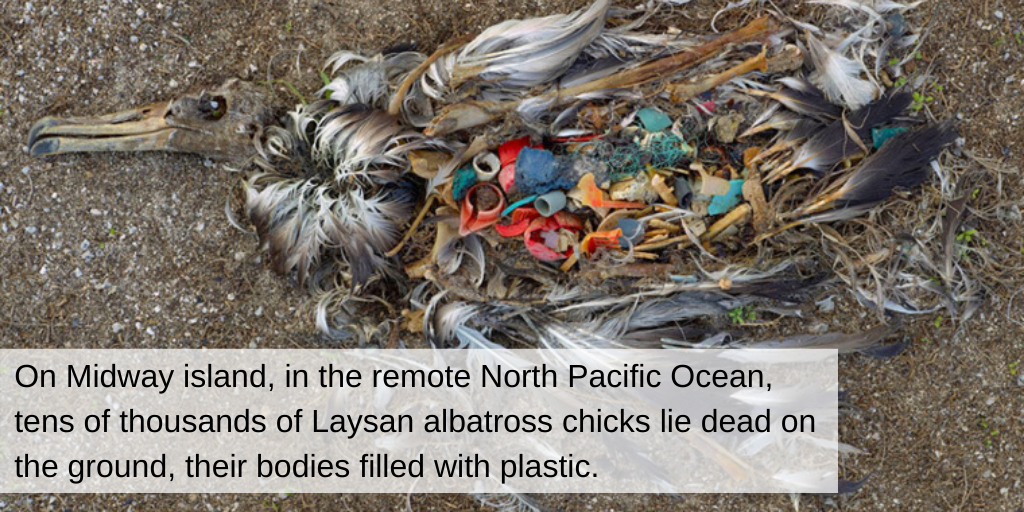Albatross Fun Facts

Fun Facts About Wisdom
Now thought to be at least 70 years old and hatched 40 or more chicks, she just hatched another chick on Feb 1st 2021.
And because Wisdom is probably 70 years it means that she has logged over 3 BILLION miles!
Sporting the red ankle band Z333, she is at least 70 this year, the oldest-known wild bird in history.
Did You Know?
- An albatross has the largest wingspan of any living bird
- They can go years without touching land
- They can live and raise chicks into their 60s
- They mate for life, with some wiggle room
- They court each other with elaborate mating dances
- They can smell food in the water from 12 miles away
Flight
Albatrosses can sleep while flying.
It takes about two months for a Laysan albatross to fly once around the earth.
An albatross is known to fly 49,700 miles without touching land. Its long and narrow wingspans are used to ride the ocean winds.
They perform specialized gliding techniques in order to minimize the use of muscles and energy.
Before taking off, an albatross needs a run up to allow enough air to move under the wings to provide lift. It is the most energy demanding part of a journey.
Albatross uses their massive wingspan to travel long distances without using their muscles.
These birds can fly for many days high in the sky and do not flap their wings once.
Taxonomy
Before taking off, an albatross needs a run up to allow enough air to move under the wings to provide lift. It is the most energy demanding part of a journey.
The black-footed albatrosses measure 27–29 in, have a wingspan of 74–86.4 in.
The laysan albatross averages 32 in in length and has a wingspan of 77–80 in.
The short-tailed albatross is a medium-sized albatross, with a wingspan of 85–91 in, and a length of 33–37 in.
The earliest albatross fossils date back to 32 million years ago.
They are known as “nomads of the oceans”.
The IUCN Red List gives the total population size of the Short-tailed albatross as 2,200-2,500 individuals, equating roughly to 1,500-1,700 mature birds.
According to IUCN’s Red List, the Laysan albatross population size totals around 591,000 breeding pairs.
The species are divided into 4 genera: Great Albatrosses, Mollywalks, North Pacific Albatross, and Sooty Albatrosses. Diomedea (Great albatrosses), Thalassarche (Mollymawks), Phoebastria (North Pacific albatrosses), and Phoebetria (Sooty albatrosses).
Feeding
The short-tailed albatross feeds mainly on squid, but will follow ships for their discarded offal.
The black-footed albatross feeds in pelagic waters, taking the eggs of flying fish, squid and to a lesser extent crustaceans. It will also consume floating debris, including plastics.
The Laysan albatross feeds predominantly on cephalopods, but also eats fish, crustaceans, and other invertebrates.
Albatross dive into the water and can reach five meters deep to get their food.
Physical Description
The Northern Pacific albatrosses have a salt gland that is situated above the nasal passage that helps desalinate their bodies, to compensate for the high amount of ocean water that they imbibe.
The short-tailed albatross, like the other albatrosses from the Northern Pacific, have a bill as long as their tail. The bill is 5.0–6.0 in long, the tail is 5.5–6.0 in.
The largest out of three species of albatross that occur in the North Pacific Ocean, the short-tailed albatross is best distinguished by its large, bubblegum-pink beak with a bluish tip.
The Northern Pacific albatrosses produce a stomach oil made up of wax esters and triglycerides that is stored in the proventriculus. This is used both against predators and as an energy rich food source for chicks and for the adults during their long flights.
Contrary to its name, the short-tailed albatross have a longer tail than the waved albatross and pretty much the same size as the black-footed and laysan albatross.
Like all albatrosses, the Laysan albatross is known to be a long-living bird. The oldest known live bird, a female named Wisdom, was at least 64 years old as of 2015. In 2014 she hatched a healthy chick which is believed to be her 36th.
Reproduction
The short-tailed albatross, from the North Pacific family, usually first breeds at 10 years of age.
The black-footed albatrosses return to the colony after three years, and spend two years building nests, dancing and being with prospective mates, a behavior that probably evolved to ensure maximum trust between the birds (raising an albatross chick is a massive energetic investment, and a long courting period establishes for both birds that the other is committed). They will start reproducing after about seven years, mating every two years.
Courtship for the laysan albatross entails especially elaborate ‘dances’ that have up to 25 ritualized movements.
The pair spends time building a nest together before they do the breeding process.
The short-tailed albatross lays a clutch of one egg that is dirty white, with red spots, mainly at the blunt end of the egg. It usually measures 4.6 in × 2.9 in. The egg is incubated for around 65 days. Both sexes incubate the eggs
When there is a shortage of food, the chicks are sacrificed so that the parents can survive.
Chicks spend four or five months staying in their nests while the parents search food.
Laysan albatrosses feeding chicks make foraging trips for as long as 17 days and will travel 1,600 miles (a straight-line distance) from their nest.
Occasionally, the birds form same-sex pairs consisting of two laysan albatross females. This phenomenon has been useful to conservation efforts in the Hawaiian Islands, where researchers have successfully swapped unfertilized eggs from female-female pairs with fertile eggs translocated from pairs nesting on military airfields and in other unsafe nesting areas. The female-female pairs then hatch and raise the foster chicks.
If there is love in nature, this is it from waitineedthat on Vimeo.
Learn more about the Northern Pacific Albatross



Sources: North Pacific Albatross, Laysan Albatross, Black Footed Albatross, Albatross facts
